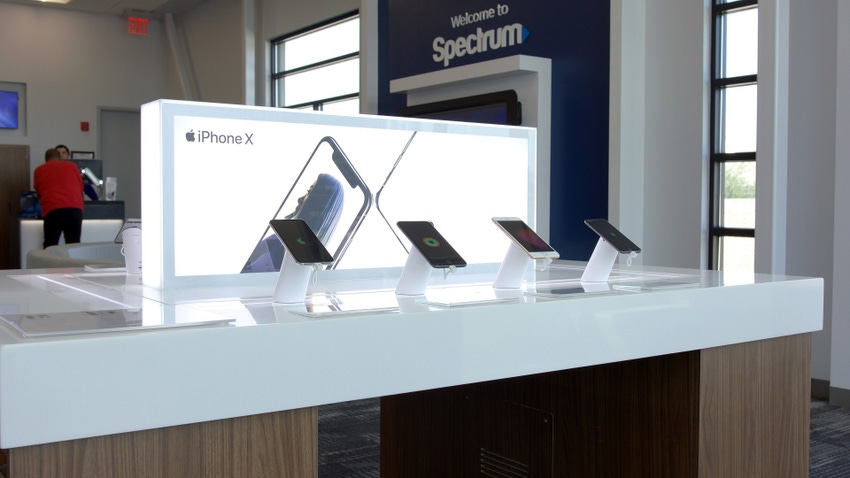Charter looks for premium treatment on Verizon's network – analyst
Charter's entry-level Spectrum Mobile plans accesses Verizon's network at a different quality of service level than similar plans from Comcast's Xfinity Mobile service, according to Recon Analytics.

Some of Charter Communications' mobile connections on Verizon's network are less likely to run into slowdowns when compared with similar offerings from those of its peer, Comcast, according to new findings from analyst Roger Entner of Recon Analytics.
"It's a deliberate strategy," Entner told Light Reading. Charter, he said, is "investing in this business [mobile] a lot more than Comcast is."
Specifically, Entner explained that some of Charter's Spectrum Mobile plans access Verizon's network at a different quality of service (QoS) level than similar plans from Comcast's Xfinity Mobile service. Among some entry-level plans, Charter's QoS Class Identifier (QCI) sits at 8, while Comcast's QCI is 9, he said. A lower number represents better QoS.
"There is a substantial price differential between QCI 9 and QCI 8," Entner said, explaining that Verizon's QCI 8 connections receive priority in times of network congestion when compared with QCI 9 connections. Charter and Comcast renegotiated their MVNO agreements with Verizon in 2021.
Entner noted that the situation probably will never affect customers living in suburban neighborhoods, where networks aren't often congested. But in urban areas where networks can become congested in the evening, there's a chance that customers with a better QoS could bump others, he said.
"There is still only a small chance [of that happening], but there is a chance," Entner said. He also noted that a QCI of 9 is standard among most entry-level plans, indicating that Charter is going beyond what other operators traditionally do with entry-level plans.
Measuring QoS
Entner said customers' QCI settings can be derived from relatively simple network tests on some Android phones. Recon Analytics routinely checks such settings for US mobile operators, he said.
Officials from Verizon didn't immediately respond to questions from Light Reading about QCI. A Charter official declined to comment on the situation. A Comcast representative confirmed the company's Unlimited Intro plan is on QCI 9, but said the company's Unlimited Plus, Premium Plus and By the Gig plans are on QCI 8.
A Verizon white paper discusses QCI: "During congestion, this translates into prioritizing of QCI 7 IP flows on the dedicated bearer on the air interface (eNB) against the QCI 8 default bearer IP flows."
QCI settings aren't the only way Charter and Comcast are looking to bolster their mobile businesses. For example, citing data from network-monitoring company OpenSignal, the financial analysts at MoffettNathanson found that Comcast customers offload an average of 93.8% of their data onto Wi-Fi, and just 6.2% goes to Verizon's cellular network. The firm found similar numbers for Charter.
Verizon's unlimited data customers, on the other hand, offload an average of 77.7% of their data onto Wi-Fi, with 23.3% going to Verizon's cellular network.
Different approaches to mobile
Entner explained that Charter and Comcast are both looking to invest into their mobile businesses, albeit in different ways.
"Not all cable companies go into this with the same motivation," he said.
For example, Charter plans to build small-scale wireless networks with equipment from Nokia. But Comcast selected Samsung for a similar project.
Further, the recent acceleration of Charter's mobile business helps underscore its interest in the sector.
"Their wireless business is growing much faster than Comcast's, reflecting their much more aggressive pricing," wrote the financial analysts at MoffettNathanson in a note about Charter's second quarter results.
During the period, Charter raked in another 648,000 mobile lines – not far off the record 686,000 lines it added in the prior quarter. The company ended the quarter with 6.62 million mobile lines.
Comcast, meanwhile, added 316,000 mobile lines in the second quarter, just below the 317,000 it added in the year-ago quarter. Comcast's mobile base now covers 5.98 million customers.
Related posts:
— Mike Dano, Editorial Director, 5G & Mobile Strategies, Light Reading | @mikeddano
About the Author(s)
You May Also Like












